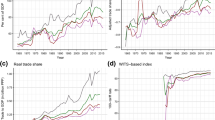Abstract
Based on the basic trade gravity model and Xinjiang’s practical situation, new explanatory variables (GDP, GDPpc and SCO) are introduced to build an extended trade gravity model fitting for Xinjiang’s bilateral trade. From the empirical analysis of this model, it is proposed that those three variables affect the Xinjiang’s bilateral trade positively. Whereas, geographic distance is found to be a significant factor influencing Xinjiang’s bilateral trade negatively. Then, by the extended trade gravity model, this article analyzes the present trade situation between Xinjiang and its main trade partners quantitatively in 2004. The results indicate that Xinjiang cooperates with its most trade partners successfully in terms of present economic scale and developing level. Xinjiang has established successfully trade partnership with Central Asia, Central Europe and Eastern Europe, Western Europe, East Asia and South Asia. However, the foreign trade development with West Asia is much slower. Finally, some suggestions on developing Xinjiang’s foreign trade are put forward.
Similar content being viewed by others
References
Aitken N D, 1973. The effect of the EEC and EFTA on European trade: A temporal cross-section analysis. American Economic Review, 63: 881–892.
Amita B, 2004. India’s global trade potential: The gravity model approach. New Delhi, India: Indian Council for Research on International Economic Relations.
Chan S H, Yoon J, 2001. Does the gravity model fit Korea’s trade patterns? Implications for Korea’s FTA policy and North Korean trade. Seoul, Korea: Korea Institute for International Economic Policy.
Chen Haiwei, 2004. Understanding the economic cooperation between Sino-Central Asian countries within the framework of the SCO. International Economics and Trade Research, 20(6): 74–77. (in Chinese)
Chen Xuegang, Yang Zhaoping, Liu Xuling, 2007. Free Trade Zone and the export-oriented economy development in Xinjiang—Conception of Urumqi Free Trade Zone (UFTZ). Arid Land Geography, 30(1): 149–155. (in Chinese)
Deardorff V A, 1998. Determinants of bilateral trade: Does gravity work in a neoclassic world? In: Frankel J A (ed). The Regionalization of the World Economy. Chicago: University of Chicago Press, 7–28.
Frankel J, David R, 1999. Does trade cause growth? American Economic Review, 89(6): 379–399.
Frankel J, Wei Shangjin, 1993. Is there a currency bloc in the Pacific? In: Wignall A B (ed.). The Exchange Rate, International Trade and the Balance of Payment. Sydney: Reserve Bank of Australia.
Hairet Tursun, Ye Wenhu, Meng Haiyan, 2000. Great exploitation of the west and the basic thoughts of the great development strategy of Xinjiang. Arid Land Geography, 23(3): 193–196. (in Chinese)
Helmers C, Pasteels J M, 2003. A gravity model for the calculation of trade potentials for developing countries and economies in transition. Geneva, Switzerland: International Trade Center.
Isard W, 1990. Introduction to Regional Science. Beijing: Higher Education Press. 50–62. (in Chinese)
Jiang Dong, Wang Haibin, Yang Xiaohuan et al., 2003. Study on the interaction between NDVI profile and the growing status of crops. Chinese Geographical Science, 13(1): 62–65.
Li Linyi, Liu Zhaoli, Li Chunlin et al., 2002. Spatial correlation analysis of crop yield in the middle and west of Jilin Province. Chinese Geographical Science, 12(2): 182–185.
Lin Ling, Wang Yan, 2004. Empirical test of China’s bilateral trade with the trade gravity model and its policy implications. World Economy Study, 7: 56–60. (in Chinese)
Linnemann H, 1966. An Econometric Study of International Trade Flows. Holland: North Holland Publishing Company.
Liu Qingfeng, Jiang Shuzhu, 2002. Study on the Chinese bilateral trade arrangement using the gravity model. Zhejiang Social Sciences, 6: 17–20. (in Chinese)
Liu Haiyan, Zhang Xiaolei, Yang Degang, 2005. Analyze and research of the modern logistics industry development in ALSK region. Arid Land Geography, 28(3): 404–406. (in Chinese)
NBSC (National Bureau of Statistics of China), 2005. Xinjiang Statistical Yearbook. Beijing: China Statistics Press. (in Chinese)
Poyhonen P, 1963. A tentative model for the volume of trade between countries. Weltwirtschafliches Archive, 90: 93–100.
Sheng Bin, Liao Ming, 2004. China’s trade flows and export potential: The gravity model approach. World Economy, 27(2): 4–10. (in Chinese)
Shi Chaoxing, Gu Haiying, Qin Xiangdong, 2005. A survey of the theoretical basis of gravity model used in international trade. Nankai Economic Studies, 2:39–40. (in Chinese)
Tinbergen J, 1962. Shaping the World Economy. New York: The Twentieth Century Fund.
Whalley J, 1998. Why do countries seek regional trade agreements? In: Frankel J A (ed.). The Regionalization of the World Economy. Chicago: University of Chicago Press, 63–82.
Author information
Authors and Affiliations
Corresponding author
Additional information
Foundation item: Under the auspices of Knowledge Innovation Program of Chinese Academy of Sciences (No. KZCS-SW-355)
Rights and permissions
About this article
Cite this article
Chen, X., Yang, Z. & Liu, X. Empirical analysis of Xinjiang’s bilateral trade: Gravity model approach. Chin. Geogr. Sci. 18, 9–16 (2008). https://doi.org/10.1007/s11769-008-0009-5
Received:
Accepted:
Issue Date:
DOI: https://doi.org/10.1007/s11769-008-0009-5




